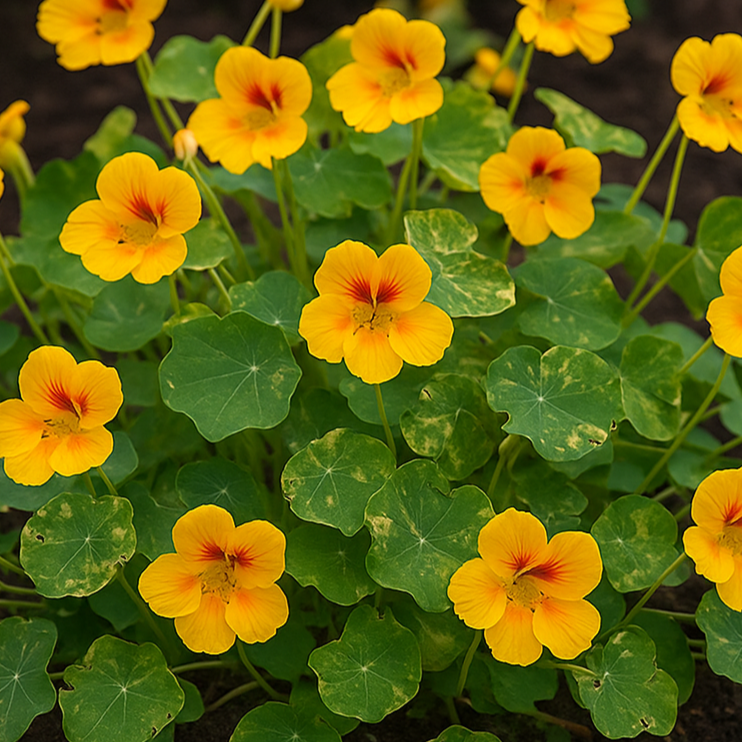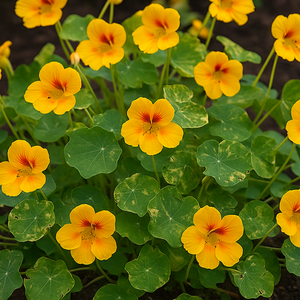- Hardiness Zone: 2-11 Annual
Seed Depth: ½ inch
Seed Spacing: 10–12 inches
Row Spacing: 18–24 inches
Sunlight: Full sun to partial shade
Days to Sprout: 7–10 days
Days to Bloom: 50–60 days
Plant Height: 10–12 inches
Plant Type: Annual
Sunlight: Prefers full sun but will tolerate partial shade, especially in hot climates.
Soil Type: Thrives in well-drained, poor to average soil. Avoid high-nitrogen soils, which encourage foliage over flowers.
When to Plant: Direct sow outdoors after the danger of frost has passed. Does not transplant well due to delicate roots.
Direct Sowing: Soak seeds overnight to speed germination. Sow ½ inch deep and space 10–12 inches apart.
Indoor Sowing: Not recommended, as nasturtiums dislike root disturbance.
Succession Planting: Stagger plantings every 2–3 weeks in spring for extended blooms, especially in cooler zones.
Watering: Water moderately. Allow soil to dry slightly between waterings—nasturtiums prefer not to sit in wet soil.
Fertilizing: Avoid fertilizing. Rich soil can reduce flowering and encourage excessive leafy growth.
Mulching: Use light mulch to suppress weeds and retain moisture, especially in containers or raised beds.
Deadheading: Remove spent blooms to encourage more flowers and prevent unwanted reseeding.
Pest Management: Monitor for aphids, especially in dense plantings. Treat with neem oil or insecticidal soap if needed.
Deadheading: Regularly remove spent blooms to encourage continuous flowering through the season.
Harvesting Fresh Flowers: Pick flowers in the morning for the best flavor and texture. Both leaves and blooms are edible with a peppery bite, perfect for salads and garnishes.
When to Harvest Seeds: Allow seed pods to mature and dry on the plant. They will turn brown and fall off easily when ready.
How to Collect: Pick dried pods from the soil or plant. Gently open to reveal large, round seeds.
Drying and Cleaning: Spread seeds in a single layer in a dry, shaded area for several days. Ensure they are fully dry before storing.
Storage Tips: Store seeds in a labeled paper envelope or airtight container in a cool, dry place. Seeds remain viable for up to 5 years.
Why You’ll Love It
Golden blooms with marbled leaves: Adds color and contrast to any garden space.
Edible and ornamental: Flowers and leaves are peppery, perfect for salads or garnishes.
Natural pest repellent: Deters aphids, whiteflies, and squash bugs.
Compact and container-friendly: Great for patios, raised beds, and edging.
Low-maintenance: Easy to grow and thrives in poor soil.
Plant Characteristics
Bloom Color: Bright golden yellow
Height: 10–12 inches
Spread: 12–18 inches
Type: Annual
Attracts: Bees, butterflies, and beneficial insects
Companion Planting Tips
Protective partner: Plant near squash, cucumbers, tomatoes, and cabbage to deter pests.
Edging plant: Works well along garden borders or around vegetable beds.
Pollinator-friendly: Encourages bees and other helpful insects near your crops.
Common Issues and Pests
Aphids: May occasionally appear but can be rinsed off or treated with neem oil.
Slugs: Attracted to tender young plants—use barriers or traps if needed.
Overwatering: Too much moisture can lead to root rot. Let soil dry between waterings.
Seeds Per Packet
| 3g | Approximately 25 |
| 5g | Approximately 42 |
Why You’ll Love It
Golden blooms with marbled leaves: Adds color and contrast to any garden space.
Edible and ornamental: Flowers and leaves are peppery, perfect for salads or garnishes.
Natural pest repellent: Deters aphids, whiteflies, and squash bugs.
Compact and container-friendly: Great for patios, raised beds, and edging.
Low-maintenance: Easy to grow and thrives in poor soil.
Plant Characteristics
Bloom Color: Bright golden yellow
Height: 10–12 inches
Spread: 12–18 inches
Type: Annual
Attracts: Bees, butterflies, and beneficial insects
Companion Planting Tips
Protective partner: Plant near squash, cucumbers, tomatoes, and cabbage to deter pests.
Edging plant: Works well along garden borders or around vegetable beds.
Pollinator-friendly: Encourages bees and other helpful insects near your crops.
Common Issues and Pests
Aphids: May occasionally appear but can be rinsed off or treated with neem oil.
Slugs: Attracted to tender young plants—use barriers or traps if needed.
Overwatering: Too much moisture can lead to root rot. Let soil dry between waterings.
Seeds Per Packet
| 3g | Approximately 25 |
| 5g | Approximately 42 |




Share and get 15% off!
Simply share this product on one of the following social networks and you will unlock 15% off!